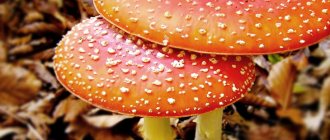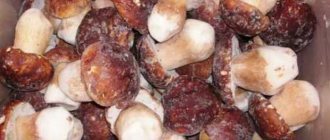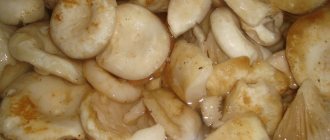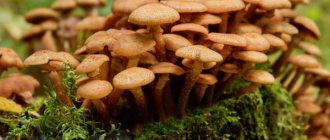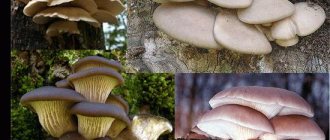Mushrooms
1
1498
Article rating
Kira Stoletova
The use of mushrooms in cooking is justified not only by the excellent taste of this product, but also by its rich chemical composition. The fruiting bodies contain many nutrients that are essential for humans, and vegetarians replace meat with them. The composition of mushrooms varies slightly depending on the species.
Chemical composition of mushrooms
Useful substances in mushrooms
The chemical composition of mushrooms is not similar to the composition of any other product. They contain from 5 to 10% dry matter. The rest is water. The product is rich in protein, it makes up 65-70% of the total substances. Mushrooms also contain carbohydrates, the amount of which is approximately the same as in other products of plant origin. They are rich in vitamins A and C; their chemical composition contains vitamins B, D, and PP. During cooking, some of the vitamins are destroyed, which is why it is not recommended to subject foods to long-term heat treatment.
Mushrooms contain no less vitamins than beef liver.
There are few minerals in the product. Potassium, copper, iron, calcium, sodium, rubidium, tin, cadmium, molybdenum, chromium, and sulfur are present. Silver is also present in the fruiting body of the mushroom in minimal quantities. Although the amount of microelements included in the chemical composition of mushrooms is small, they are enough for a person to receive more than half the daily requirement of essential substances.
Useful and harmful qualities of mushrooms
Mushrooms should be eaten with caution as they can be both beneficial and harmful if consumed in large quantities. There is no need to remind you about the presence of conditionally poisonous and poisonous mushrooms. Limit consumption of this product by children.
Mushrooms contain a very large amount of protein, which is involved in the formation of cells. Its indicator even exceeds the indicators of this element in meat or fish. In addition, they contain a huge number of vitamins, amino acids and minerals, 70% of which are easily digested and stored in the body.
The full list of beneficial properties depends on the specific type of mushroom. For example, champignons stimulate the heart, increase blood circulation, remove waste, toxins and other harmful elements. Porcini mushrooms include rare antibiotics that can fight harmful bacteria in the gastrointestinal tract and may prevent the development of cancer.
Along with the beneficial properties, there are also warnings. This product should not be used by children under 5 years of age or by adults with stomach problems. Mushrooms are difficult to digest and absorb into the body, so it is important to eat them well cooked.
The nutritional value
There are fewer useful substances in the chemical composition of mushrooms with age, which is why it is better to avoid old specimens. Depending on the variety, calorie content varies from 9-35 kcal for every 100 g of fresh product, which makes mushrooms popular with nutritionists. The boletus, a representative of the Bolet genus, is high in calories. The smallest number of calories is contained in nigella. On the contrary, 100 g of dried product contains from 150 to 320 kcal. The same goes for homemade pickles. It is difficult to judge the calorie content of store-bought products due to the fact that their chemical composition contains a high content of various additives.
Irina Selyutina (Biologist):
In their chemical composition, almost all mushrooms resemble a mixture of meat and vegetables. That’s why they are called “forest meat” or “forest bread.” It is estimated that dried mushrooms contain about 30% protein (however, young mushrooms contain more than old mushrooms). In terms of protein content and amino acid composition, mushrooms are closer to vegetables. They contain 18 of the 20 protein-forming amino acids. Of these, 8 are irreplaceable, i.e. they are not synthesized in the human body.
Since the cell membranes of mushrooms include the polysaccharide chitin, which is not absorbed in the human gastrointestinal tract, it is necessary to prepare mushrooms in such a way as to free up the cell contents to the maximum, which the human body cannot handle. To do this, fresh mushrooms are finely chopped, and dry mushrooms are ground. Both are processed thermally, which increases the absorption of the mushroom pulp, or more precisely, the proteins contained in it by up to 70%.
The fruiting body of the mushroom contains a large amount of lipids, which is 1.3-2.7%, this figure is several times higher than the amount of fat in vegetable crops. Polyunsaturated fatty acids, which are essential (not synthesized) for the human body, make up about 67% of the mass of lipids. They ensure normal tissue development, metabolism and prevent cholesterol from settling on the walls of blood vessels.
The main part of the carbohydrates contained in the mushroom body belongs to the fiber fraction and normalizes the functioning of the intestinal microflora and helps remove cholesterol and toxins from the body.
The ratio of proteins, fats and carbohydrates (kbzhu or bzhu) varies significantly depending on the type. So, for example, 100 g of fresh boletus contains 3.7 g of protein, 1.7 g of fat, 3.4 g of carbohydrates. Calorie content is 30 kcal. Dried boletus, deprived of water, contains 20.1 g of protein, fat and carbohydrates are 4.8 g and 27.6 g, respectively. Calorie content – 150 kcal. The highest rates are for dried aspen boletuses. They contain 35.4, 5.4, 39.7 g of proteins, fats and carbohydrates, respectively. Calorie content is 240 kcal. The indicators for fresh oilseeds are low. With an energy value of 9 kcal, they contain 2.4, 0.7, 1.7 g of proteins, fats and carbohydrates. It is not possible to list all varieties of kbju. There is a table on product packaging that displays such information.
The time for digestion of a product of any type (type) in the human gastrointestinal tract remains unchanged. It is 150 minutes.
When cooking, you need to take into account that not all parts of the mushroom have the same nutritional value. So, the caps have less mushroom fiber, so they are more easily absorbed by the human body. The legs are less digestible due to the presence of a large amount of fungin in them, which gives each fungal cell strength. In old mushrooms, it is recommended to remove the spore-bearing layer - it is of nutritional value only in young specimens before spores form. The peel covering the cap also needs to be removed, because most often it is in it that harmful substances are collected in a “close group”.
How to cook better
After all, most foodies don't think about whether mushrooms are protein or carbohydrate. It's simply delicious. Your favorite product is boiled, fried, stewed, salted, pickled. Some of the species, for example champignons, are also consumed raw. What do you need to remember about mushroom dishes?
- Fried “forest meat” is tastier, but when fried it absorbs a lot of fat, and its dietary properties are reduced.
- The longer the mushrooms are cooked and the finer they are cut, the faster they are digested by the body.
- Salted and pickled mushrooms retain all their beneficial properties, and their digestibility increases.
- Dried mushrooms are the highest in calories.
- White mushrooms, chanterelles, boletus, boletus, and boletus can not be pre-boiled, but can be cooked immediately in a dish.
- You only need to cook the mushrooms over low heat.
- You cannot mix tubular and lamellar mushrooms in one dish.
Enjoy the exceptional gift of nature and be healthy.
Groups of mushrooms
Based on taste, mushrooms are divided into four groups
According to nutritional value and taste, all mushrooms are divided into 4 groups. The 1st group included boletus, pine camelina and r. spruce, cultivated champignon. By the way. All species in which the stem and cap are painted white have high taste. Boletus, boletus, milk mushroom (blue, aspen) and boletus are included in the 2nd group, their nutritional value and taste are slightly inferior to Boletus. Russula (not all), honey mushrooms (autumn) and valui are classified in the 3rd group. Mushroom pickers take them less often. The 4th group includes oyster mushrooms (common, autumn), oyster mushrooms (white, black) and russula (not all). If you cook them correctly, you will get tasty and healthy dishes.
Recipes with mushrooms
Some protein diets for weight loss are based on mushrooms. Here are some simple recipes.
Mushrooms stewed with apple
To prepare the dish, take:
- fresh chanterelles – 500g;
- olive oil – 3 tbsp. l.;
- green apple – 3 pcs.;
- flour – 1 tbsp. l.;
- mushroom decoction – ½ tbsp.;
- low fat sour cream – 120 g;
- salt;
- greenery.
Cut the mushroom stems, do not chop the caps. Simmer them in oil until half cooked, then add apples. Mix the mushroom broth with sour cream and pour into the mushrooms, then add the sour cream. After boiling, add salt and turn everything off.
Stewed oyster mushrooms
For a simple dietary dish, take:
- oyster mushrooms – 500 g;
- low fat sour cream – 100 g;
- onions – 3 pcs.;
- chicken egg yolk – 1 pc.;
- olive oil – 30 ml;
- salt;
- black pepper.
Mushrooms need to be rinsed with boiling water, then cut as you like, but not finely. Sauté them together with the onions in oil. Fill with water and simmer a little (30 minutes). Add sour cream and keep on the stove for another 7 minutes.
Mushrooms are a healthy and tasty delicacy that should be present in the diet. Pay attention to their selection and proper preparation to get the maximum vitamins.
Interesting Facts
To get the most out of a product, it must be prepared correctly. It is also better to know about the special properties of mushrooms:
- Mushrooms contain small amounts of minerals, including calcium. But this microelement is absorbed a little better if you serve a mushroom dish with sour cream or milk.
- The protein content in mushrooms is high. To get its daily requirement, 250 g of fresh boletus or half of this portion of dried boletus is enough. Their systematic use leads to improved functioning of the cardiovascular and immune systems. Mushrooms also contain substances that can prevent the appearance of various tumors in the body, which is why they are recommended as a cancer prevention.
- Mushrooms, which include vitamin C and carotene, are deprived of these substances during prolonged heat treatment. The optimal cooking time is no more than 10-15 minutes. Therefore, it is better to prepare dishes from small mushrooms, which are cooked in the oven for 7-10 minutes. You shouldn't eat them raw. This can cause disturbances in the gastrointestinal tract.
- Mushrooms are not just about protein or carbohydrates. In laboratory conditions, substances are obtained from them that are used to prepare medicines. In particular, antibiotics (penicillin, for example) and antibacterial drugs are made from them. In folk medicine, edible mushrooms are used to make medicines for alcoholism and painkillers. Traditional healers also use inedible species. However, it is better to avoid taking such drugs.
- The presence of zinc in mushrooms makes the product valuable during a diet. This microelement in the composition of fruiting bodies allows you to speed up carbohydrate metabolism. As a result, all food is digested and calories do not add extra weight. With a lack of zinc, a person craves sweets or alcohol. It will be more useful to compensate for this deficiency with the help of mushrooms, which will not harm the figure. Zinc also improves potency.
- Enzymes present in mushrooms help normalize blood cholesterol levels. Oyster mushrooms cope best with this task. To lower blood cholesterol levels by 10%, include 50 g of oyster mushrooms in your daily diet.
- Of the enzymes capable of breaking down fats and glycogen, amylase, lipase, cytase, and urethase were discovered in fungal cells.
- The largest amount of fat is contained in the hymenium, less in the stalk.
Are mushrooms a protein or a carbohydrate?
Nowadays you don’t have to go to the forest to pick mushrooms. You can go to a store or market. People have learned to grow valuable products in special greenhouses. Mushrooms are consumed in any form, used for medicinal purposes, and included in the menu of Lenten dishes. What do mushrooms contain? Ingredients: proteins, fats, carbohydrates, water, fiber, minerals, vitamins. The largest percentage of the total composition of the mushroom (about 90%) is water. The proteins, fats, and carbohydrates that make up the mushrooms are distributed in the proportion of 3.2%: 1%: 3.7%, respectively. The question of whether mushrooms are protein or carbohydrate is difficult to answer unequivocally. In terms of protein composition, they are similar to meat, but their properties are still closer to plants.
Harm from mushrooms
Mushrooms are carbohydrates, protein, enzymes and other substances necessary for the normal functioning of the body. However, in some cases they pose a danger to human health. Due to the peculiarities of their chemical composition (for example, the presence of chitin in the cell wall), mushrooms are difficult for the digestive system; many enzymes are required for their processing. Because of this, they are not given to children and the elderly. For people with gastrointestinal diseases, it is better to first consult with their doctor.
It is better to collect these gifts of the forest yourself. The content of toxic substances in edible mushrooms growing near highways and enterprises is high. They absorb many substances from the environment like sponges. The product is collected in ecologically clean areas.
Mushrooms are digested only 2.5 hours after consumption, so it is better to eat them for breakfast or lunch. To avoid flatulence (bloating), they are not combined with fresh vegetables. It is better to remove the shell covering the cap before cooking. They go on a “silent hunt” with the appearance of the first spring rains. With enough water, mushrooms quickly increase in size. It is important to do it before the mushroom, which is 90% water, loses most of its nutrients.
Be careful: mushrooms!
We won’t talk about poisonous mushrooms. Everyone knows that they are not just harmful, but deadly. Let's talk about useful and favorite ones - edible. Why, despite all their benefits, nutritionists advise those who have stomach problems, pregnant women and children to refrain from excessive consumption? The fact is that mushroom protein is significantly different from meat protein. It contains chitin, a substance that slows down the digestion process, which can take up to six hours. This property has brought mushrooms the reputation of being a difficult-to-digest product. But it is chitin that helps the body fight E. coli. So everything is good in moderation.
In addition, the structure of the mushroom tissue allows it to absorb the entire composition of the environment through its pores. Mushrooms grown near large busy highways, in places where chemicals accumulate, or in unfavorable radiation conditions, can become a serious danger. That is why it is not recommended to buy them secondhand, because they are collected in unknown places.
Mushroom pickers must remember:
- You cannot pick mushrooms along the road.
- The older the mushroom, the more undesirable substances it can accumulate. It is better not to take large overgrown ones.
- Much more useful substances are found in the cap rather than in the stem.
Properties of mushrooms
In fact, our forests contain about 300 varieties of mushrooms that can be eaten. But even avid mushroom pickers are unlikely to tell you more than 15. Of course, you need to approach mushroom picking with the utmost caution, because poisoning can be very serious. However, it would be nice to know about some varieties that are not so common, but are edible - umbrellas, ring caps and others.
Water in mushrooms
A freshly cut mushroom contains a lot of liquid. You can notice this when you start cooking it. When cooking mushrooms, the amount of water is reduced by half, and when dried, it almost completely disappears.
Useful substances in mushrooms
Mushrooms are often called “plant meat” because they contain a lot of protein. What distinguishes them from meat products is that, in addition to proteins, they largely consist of healthy fiber, which contributes to the normal functioning of the digestive system, and carbohydrates.
Nutritional value of mushrooms
Numerous discussions around the benefits of mushrooms for the body ended with the conclusion that they are actually useful and contain many vitamins and microelements necessary for humans.
Mushrooms are closest in composition to vegetables, but they are distinguished by their high protein content.
Mushrooms: a source of vegetable protein, healthy fiber, many minerals, carbohydrates and vitamins
Cereals
It was not for nothing that Hercules received its name in honor of the ancient Greek hero. Oatmeal (rolled oats) contains 10–12 g of protein, as well as all minerals and vitamins. Oatmeal is easily digestible, so this porridge will give you strength for the whole day. There is an exotic type of cereal - quinoa, which contains 14 g of protein. This is one of the most useful products, which, unfortunately, is not always easy to find in stores. On average, grains contain 6 g of protein and many other healing substances.
About the benefits of the product
The main elements that mushrooms contain (proteins, fats and carbohydrates) are in the proportion most beneficial for nutrition. A fairly large percentage of proteins with a small (1%) fat composition makes this product dietary. In addition, mushrooms contain almost the complete set of amino acids and vitamins necessary for the body. A whole set of micro- and macroelements was found in mushrooms, such as zinc, cobalt, copper, iron, potassium, calcium and others.
These forest dwellers are able to help a person with disorders in the functioning of certain organs. Let's look at the most famous ones as an example:
- White mushrooms. Proteins, fats, carbohydrates create the most favorable composition in their composition. These forest beauties can successfully resist E. coli and Koch's bacilli.
- Chanterelles cleanse the liver, are useful for headaches, and suppress staphylococci.
The presence of potassium and copper in mushrooms helps remove excess water from the body and improves skin elasticity.






